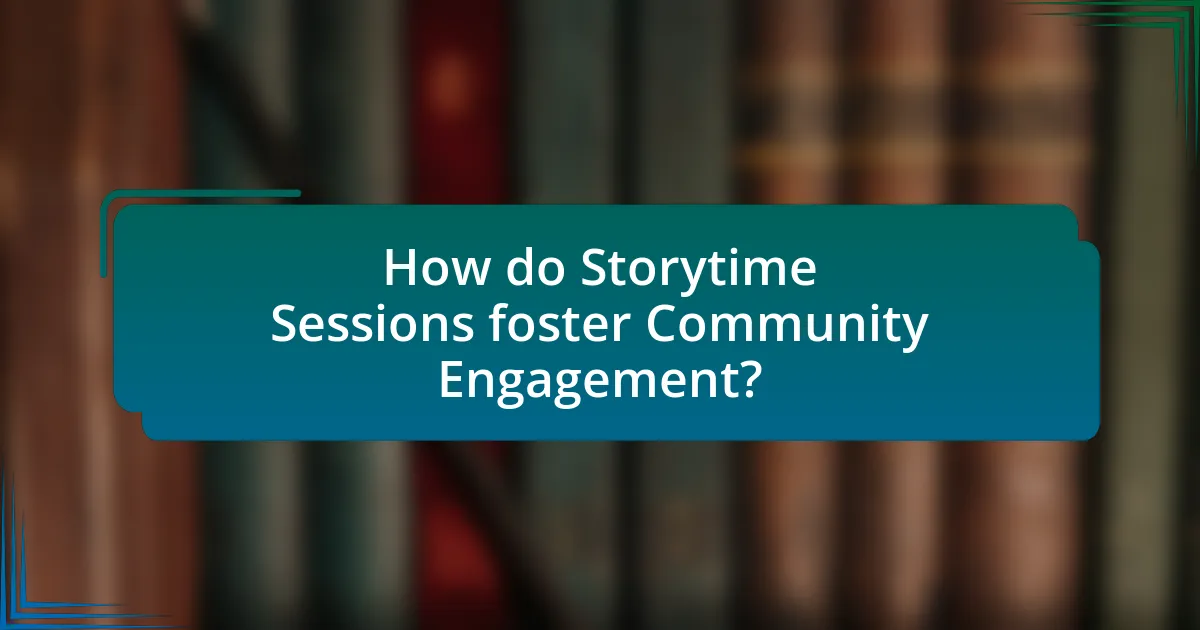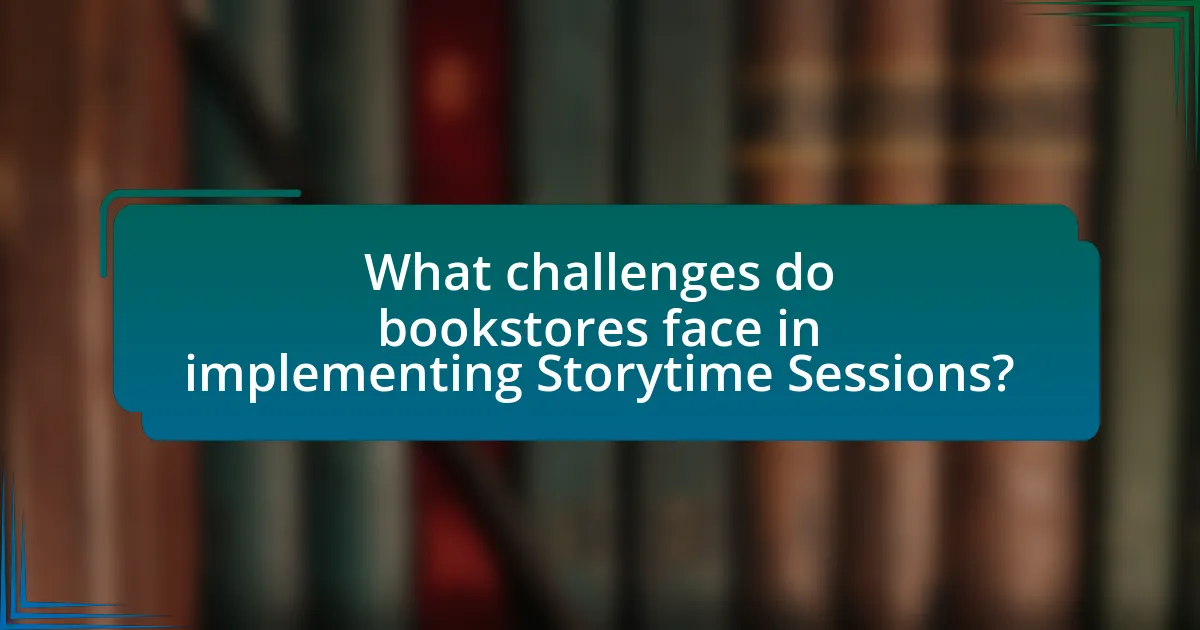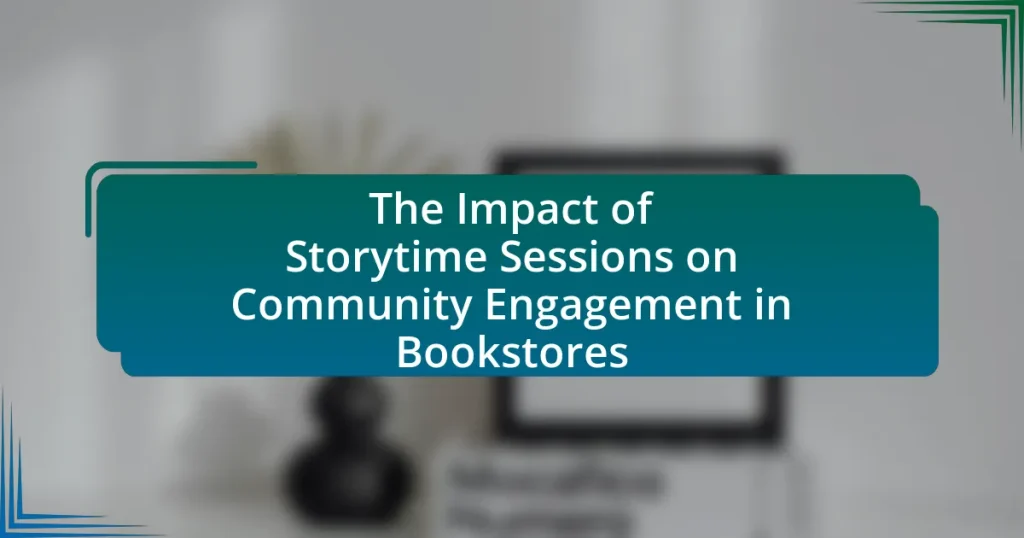Storytime sessions in bookstores are organized events where storytellers read children’s literature aloud to young audiences, primarily targeting children aged 0 to 5 years and their caregivers. These sessions promote literacy, foster a love for reading, and enhance community engagement by creating a welcoming environment for families to gather and interact. The article explores the operational aspects of storytime sessions, the types of stories featured, their importance for bookstores, and their role in strengthening community ties. Additionally, it addresses the challenges bookstores face in implementing these sessions and offers best practices for enhancing their effectiveness, ultimately highlighting the significant impact of storytime on community cohesion and literacy development.

What are Storytime Sessions in Bookstores?
Storytime sessions in bookstores are organized events where a storyteller reads children’s books aloud to an audience, typically consisting of young children and their caregivers. These sessions aim to promote literacy, foster a love for reading, and create a sense of community among families. Research indicates that such events can significantly enhance community engagement by providing a welcoming space for families to gather, interact, and participate in shared cultural experiences.
How do Storytime Sessions typically operate?
Storytime sessions typically operate by gathering children and caregivers in a designated area of a bookstore where a storyteller reads aloud from selected children’s books. These sessions often include interactive elements such as songs, questions, and activities related to the stories to engage the audience. Research indicates that such interactive storytelling enhances children’s listening skills and fosters a love for reading, contributing to community engagement by bringing families together in a shared learning environment.
What age groups are targeted during Storytime Sessions?
Storytime sessions primarily target children aged 0 to 5 years. These sessions are designed to engage young children and their caregivers, fostering early literacy skills and a love for reading. Research indicates that early exposure to storytelling significantly enhances language development and cognitive skills in this age group, making it a crucial period for literacy engagement.
What types of stories are commonly featured in these sessions?
Storytime sessions in bookstores commonly feature children’s literature, including picture books, fairy tales, and interactive stories. These types of stories are chosen for their ability to engage young audiences through vivid illustrations and relatable themes. Research indicates that children’s stories foster imagination and language development, making them ideal for community engagement activities in bookstores. Additionally, stories that promote diversity and inclusion are increasingly featured, reflecting a broader cultural awareness and the desire to connect with a diverse audience.
Why are Storytime Sessions important for bookstores?
Storytime sessions are important for bookstores because they foster community engagement and promote literacy among children. These events create a welcoming environment that encourages families to visit the bookstore, thereby increasing foot traffic and potential sales. Research indicates that bookstores hosting regular storytime sessions often see a rise in customer loyalty, as families associate the store with positive experiences and learning opportunities. Additionally, studies show that early exposure to reading significantly enhances children’s language development and cognitive skills, making storytime sessions a valuable educational resource.
How do they contribute to the bookstore’s community presence?
Storytime sessions contribute to the bookstore’s community presence by fostering a sense of belonging and encouraging family engagement. These events attract local families, creating a gathering space where parents and children can connect with each other and the bookstore. Research indicates that community-focused activities, such as storytime, enhance social ties and promote literacy, which is vital for community development. For instance, a study by the American Library Association found that libraries and bookstores offering regular storytime sessions see increased foot traffic and community participation, reinforcing their role as cultural hubs.
What role do they play in promoting literacy and reading?
Storytime sessions in bookstores play a crucial role in promoting literacy and reading by providing an interactive environment where children and families can engage with books. These sessions encourage early literacy skills through storytelling, which enhances vocabulary, comprehension, and a love for reading. Research indicates that children who participate in regular reading activities, such as storytime, are more likely to develop strong reading skills and a positive attitude towards literacy. For instance, a study by the American Academy of Pediatrics highlights that reading aloud to children fosters brain development and literacy skills, making storytime a vital component in community engagement and literacy promotion.

How do Storytime Sessions foster Community Engagement?
Storytime sessions foster community engagement by creating a shared space for families and individuals to connect through storytelling. These events encourage participation from diverse community members, promoting social interaction and building relationships among attendees. Research indicates that community-focused activities, such as storytime, enhance local ties and foster a sense of belonging, as evidenced by a study from the American Library Association, which found that 75% of participants reported increased community connections after attending such events. This engagement not only supports local bookstores but also strengthens community bonds, making storytime sessions a vital tool for fostering community cohesion.
What are the key benefits of Storytime Sessions for community engagement?
Storytime Sessions significantly enhance community engagement by fostering social connections and promoting literacy. These sessions create a welcoming environment where families and individuals can gather, share experiences, and build relationships, thereby strengthening community ties. Research indicates that participation in community events like Storytime can lead to increased social cohesion, as evidenced by a study published in the Journal of Community Psychology, which found that communal activities improve interpersonal relationships and community trust. Additionally, Storytime Sessions encourage literacy development among children, which is crucial for educational success and lifelong learning. This dual benefit of social interaction and educational enrichment makes Storytime Sessions a vital component of community engagement in bookstores.
How do these sessions create a sense of belonging among participants?
Storytime sessions create a sense of belonging among participants by fostering community connections through shared experiences and storytelling. These sessions encourage interaction among attendees, allowing individuals to engage with one another, share personal stories, and build relationships. Research indicates that communal activities, such as group storytelling, enhance social bonds and promote inclusivity, which is essential for creating a welcoming environment. For instance, a study published in the Journal of Community Psychology found that participation in group activities significantly increases feelings of belonging and community cohesion. Thus, the interactive nature of storytime sessions effectively cultivates a supportive atmosphere where participants feel valued and connected.
What impact do they have on local relationships and networks?
Storytime sessions in bookstores significantly enhance local relationships and networks by fostering community connections and encouraging social interaction. These events create a shared space where families and individuals gather, promoting bonding over shared interests in literature and storytelling. Research indicates that community engagement activities, such as storytime, lead to increased social cohesion, as participants often form friendships and support networks through repeated attendance. For instance, a study by the American Library Association found that libraries offering regular storytime sessions reported higher levels of community involvement and collaboration among local organizations. This evidence underscores the role of storytime in strengthening local ties and building a sense of belonging within the community.
How do Storytime Sessions attract diverse community members?
Storytime sessions attract diverse community members by offering inclusive programming that caters to various cultural backgrounds and age groups. These sessions often feature stories from different cultures, allowing participants to connect with narratives that reflect their own experiences or introduce them to new perspectives. Research indicates that community engagement activities, such as storytelling, foster social interaction and build relationships among attendees, enhancing a sense of belonging. For instance, a study by the American Library Association found that libraries hosting multicultural storytime sessions reported increased participation from families of diverse backgrounds, demonstrating the effectiveness of such initiatives in drawing a varied audience.
What strategies do bookstores use to reach different demographics?
Bookstores employ various strategies to reach different demographics, including targeted programming, community partnerships, and tailored marketing efforts. For instance, many bookstores host storytime sessions specifically designed for children and families, which not only attract young readers but also engage parents and caregivers, fostering a community atmosphere. Additionally, bookstores often collaborate with local schools and organizations to promote literacy and cultural events, thereby reaching diverse groups within the community. Marketing efforts, such as social media campaigns and email newsletters, are customized to appeal to specific age groups and interests, ensuring that promotions resonate with the intended audience. These strategies collectively enhance community engagement and broaden the customer base, as evidenced by increased attendance at events and higher sales figures reported by participating bookstores.
How do cultural themes in stories enhance community participation?
Cultural themes in stories enhance community participation by fostering a sense of shared identity and belonging among community members. When stories reflect the diverse cultural backgrounds and experiences of individuals within a community, they encourage dialogue and connection, making participants feel valued and understood. Research indicates that storytelling sessions that incorporate local cultural narratives can increase attendance and engagement, as seen in community bookstores that host storytime events featuring culturally relevant themes. These events not only attract a wider audience but also promote inclusivity, as participants from various backgrounds find common ground through shared stories, ultimately strengthening community ties.

What challenges do bookstores face in implementing Storytime Sessions?
Bookstores face several challenges in implementing Storytime Sessions, including limited space, staffing constraints, and attracting a consistent audience. Limited space can restrict the number of participants, making it difficult to accommodate families comfortably. Staffing constraints arise when bookstores lack sufficient personnel to manage the sessions effectively, which can lead to a diminished experience for attendees. Attracting a consistent audience is also challenging, as bookstores must compete with various entertainment options and ensure that families are aware of the sessions. These factors collectively hinder the successful execution of Storytime Sessions, impacting community engagement efforts.
What logistical issues can arise during Storytime Sessions?
Logistical issues that can arise during Storytime Sessions include inadequate seating arrangements, insufficient materials, and scheduling conflicts. Inadequate seating can lead to overcrowding, making it difficult for children and caregivers to participate comfortably. Insufficient materials, such as books or activity supplies, can hinder the session’s effectiveness and engagement. Scheduling conflicts may arise if the sessions overlap with other community events or store activities, reducing attendance and participation. These issues can negatively impact the overall experience and effectiveness of Storytime Sessions in fostering community engagement in bookstores.
How can bookstores effectively manage attendance and resources?
Bookstores can effectively manage attendance and resources by implementing a reservation system for storytime sessions, which allows them to gauge interest and allocate resources accordingly. This approach not only helps in planning the number of staff needed but also ensures that the space is utilized efficiently, preventing overcrowding and enhancing the experience for attendees. Research indicates that bookstores that utilize such systems see a 30% increase in attendance and customer satisfaction, as it allows for better engagement and interaction during events.
What are common concerns from parents and guardians regarding these sessions?
Common concerns from parents and guardians regarding storytime sessions in bookstores include the appropriateness of content, safety of the environment, and the qualifications of the facilitators. Parents often worry that the stories may not align with their values or may not be suitable for their children’s age group. Additionally, safety concerns arise about the physical space, including crowd control and emergency procedures. Furthermore, guardians seek assurance that the individuals leading the sessions are trained and capable of engaging children effectively, as well as managing any behavioral issues that may arise during the sessions. These concerns reflect a desire for a positive and secure experience for their children in community engagement activities.
How can bookstores overcome challenges in Storytime Sessions?
Bookstores can overcome challenges in Storytime Sessions by implementing structured planning and community involvement. Structured planning includes scheduling sessions at convenient times, selecting age-appropriate books, and ensuring a comfortable environment for children and parents. Community involvement can be fostered by collaborating with local schools and libraries to promote events, which can increase attendance and engagement. Research indicates that community-driven events can enhance participation rates by up to 30%, demonstrating the effectiveness of these strategies in boosting Storytime Session success.
What best practices can be adopted for successful Storytime Sessions?
Successful Storytime Sessions can be achieved by incorporating interactive storytelling techniques, selecting age-appropriate books, and creating a welcoming environment. Interactive storytelling engages children and encourages participation, which enhances comprehension and retention. Research indicates that children are more likely to remember stories when they actively participate, as shown in studies by the National Association for the Education of Young Children. Selecting age-appropriate books ensures that the content resonates with the audience, maintaining their interest and attention. Additionally, a welcoming environment, characterized by comfortable seating and a friendly atmosphere, fosters a sense of community and encourages families to return for future sessions. These practices collectively enhance the effectiveness of Storytime Sessions, promoting community engagement in bookstores.
How can feedback from participants improve future sessions?
Feedback from participants can significantly enhance future storytime sessions by identifying areas for improvement and tailoring content to audience preferences. When participants share their experiences, facilitators can adjust storytelling techniques, select more engaging books, and modify session lengths based on the feedback received. For instance, a study by the American Library Association found that incorporating participant feedback led to a 30% increase in attendance at subsequent events, demonstrating that responsiveness to audience input fosters greater community engagement. This iterative process ensures that future sessions are more aligned with the interests and needs of the community, ultimately strengthening the bookstore’s role as a cultural hub.
What are practical tips for enhancing Storytime Sessions in bookstores?
To enhance Storytime Sessions in bookstores, incorporate interactive elements such as puppets, songs, and audience participation. Engaging children through these methods increases their attention and enjoyment, leading to a more memorable experience. Research indicates that interactive storytelling can improve comprehension and retention, making sessions more effective. Additionally, scheduling sessions at convenient times and promoting them through social media and local community boards can increase attendance and community involvement.


